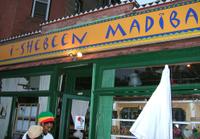 RESTAURANT: Madiba
RESTAURANT: MadibaLOCATION: 195 Dekalb Avenue, Brooklyn
DATE: July 7, 2005
FOOD: Appetizer: Uputhu (ground cornmeal with tomato and onion gravy); Split following entrees: Prawns Peri-Peri (grilled Mozambique style prawns served with yellow rice and salad); Breyani with chicken (rice and lentil stew with a boiled egg and a selection of sambals); Dessert: Mom’s Tipsey Tart (crammed with nuts and dates, soaked with Klipdrift brandy syrup, served with ice cream).
BEVERAGE: Tap Water; Decaf Coffee
PRICE: $37.00
It’s the culinary equivalent of the glass half-empty, glass half-full situation. In New York, trying to choose among the hundreds of restaurants for a given ethnic cuisine is an often daunting and even debilitating task. Stay in the city for Mexican or head out to Queens? Thai at Klong on St. Marks St or head out to Sripriphai? The possible dilemmas are endless for each nationality. Well, usually that is. An exception is South African restaurants. New York has just one. Literally. Located in Brooklyn, Madiba is the only South African restaurant this city has to offer. That makes choosing where to go for South African food easy. But as Soviet Russia so ineptly showed us, without the antagonism of competition, quality suffers.
Thus, Madiba was the de-facto choice for the July’s People meeting of Infinite Feast. The restaurant is a huge space, decorated creatively in various paraphernalia from Africa. Patrons enter through a pseudo grocery store (part of an early 21st expansion of the restaurant), before being seated in the cavernous dining area. Dining at Madiba is partially about the food, partially about the experience. Antique desks are used as tables and all drinks are served in Mason jars. It’s these touches that give the restaurant a very organic atmosphere, a vibe that is distinctly non-New York. Dinner is almost like a mini-Safari vacation – except instead of the wildlife running through brush, it comes chopped, stewed, and grilled on your plate.
Though listed as a side dish, the Uputhu served as a steady, if a bit heavy, appetizer. Reminiscent of Italian polenta, Latin American corn meal, or American grits, the Uputhu was a hearty and thick hominy. Coupled with a straightforward tomato and onion gravy that continued the similarity to Italian traditions, the Uputhu may have an unfamiliar name, but its taste would be common to most American palates. The dish as a whole was pleasing, but only because the gravy covered up for the dry and congealed cornmeal. Like buffet oatmeal or grits that have sat out to long, the cornmeal tasted stale and lacked freshness. The temperature of the dish also indicated that perhaps the mixture had larded in a pot, made beforehand, but then left unattended for hours.

Next came the main courses, chicken breyani and prawns peri-peri. Like the Indian meal that bears the same name, the chicken breyani was a large plate of rice, filled with chicken, beans, and accompanied by a hard-boiled egg. However, unlike its Indian relative, Madiba’s breyani was stringy and uneven, parched in some sections, slimy in others. Overall, though skillfully seasoned and tantalizingly promising, the breyani best deserves the tag of mediocrity. Infusing the dish with an increased amount of beans or other vegetables would have made it much more successful.
The prawns peri-peri displayed greater consistency, which made up for an unimaginative and ordinary preparation, severely lacking the pizzazz or novelty often found in offbeat cultural restaurants. Juicy prawns and feathery yellow rice were held back by mundane seasoning. A hint of heat or a spice rub completely dissimilar to American flavorings would have made the dish special. Instead, it was like everything else – okay.
But like the popular novelist in Calvino’s If on a winter’s night a traveler who tries to salvage his reputation by writing a “serious” work in his later years, Madiba tried to save itself through dessert. It damn near succeeded, as the Mom’s Tipsy Tart was an exquisite blend of brandy, nuts, and dates, a dish finally displaying the combination of Mediterranean, north African, and sub-Saharan African influences expected throughout the rest of the meal. Like a South African Christmas pudding or bread pudding on a bender, this dessert combined salty and sweet flavors with the caustic, yet welcoming liquor embrace. The tipsy tart managed to place a high level of complexity in an accessible and engaging form. It’s to desserts what Vonnegut is to contemporary literature.
Madiba would be well-served by some friendly South African competition. Judging Madiba is like a university trying to assess the merits of a smart kid who is home-schooled. Sure the child has all kinds of great attributes, but having never faced any kind of competition, how can the school really know how intelligent or successful the student is? This is America after all, we’re born and bred on competition. If we didn’t have crazed parents pushing their children into beauty pageants and talent contests at the age of three or parents punching other parents during Little League baseball games, some of the greatness the Founding Fathers imbued this country with would be lost. Besides the wonderful dessert, nothing really stuck out at Madiba. Again, the glass half-empty/half-full scenario pertains. While it’s always nice to have a meal where every dish is good, it’s also a little disappointing when everything is good but unspectacular. If New York had at least one other South African restaurant, deciding whether this mediocrity is based on some intrinsic quality of South African cuisine or if Madiba just needs to up its game. There are no SAT scores for restaurants, just word of mouth and personal preference, so maybe Madiba is outstanding and South African food generally is bland – but I’d bet against this. But for the time being at least, the question is moot, as Madiba is the only game in town.
RATING: 6.5/10
No comments:
Post a Comment